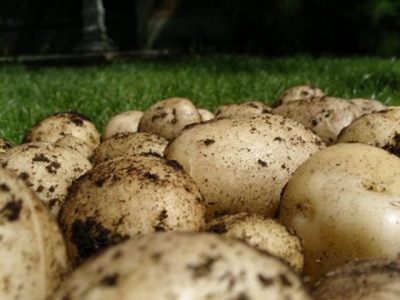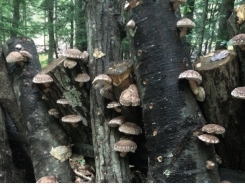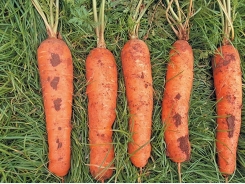Growing Potatoes Successfully – Seed Potatoes

Growing Potatoes
Garden lore is permeated with myths and one of the most misleading is that growing potatoes will break up the soil. Potatoes do nothing of the sort; it is the person who plants and grows them that does this job. Although potatoes will grow in almost any soil, except that which is continuously waterlogged, and produce a crop of sorts, they require a rich well-broken up soil more than any other vegetable. True, after growing potatoes the soil is pretty well broken up – first of all by the digging, then the earthing up and subsequently by lifting the crop; no other crop receives these three manipulating operations.
The condition of the soil following a crop of potatoes is better because, in addition to this manipulation, the sprawling and dense foliage tends to smother out annual weed seedlings. All the same, unless the hoe is used freely or the weeds between the rows are sprayed with weedkiller they could easily take over and smother out the potatoes.
Probably the most important preparation for potatoes is the breaking up of the soil as finely as possible. Lumpy soil not only impedes the development of the tubers but actually distorts them – as an examination of imported potatoes which have been grown on dryish soil will reveal. Do not use ashes or other gritty materials to improve heavy land for potatoes as these scratch the skins of the young tubers and can actually cause a rough scabbiness which should not be confused with a disease called scab. Rotted or composted organic material is always good for potato land but it should be kept below the planted tubers.
A word of warning about the indiscriminate use of chemical fertilisers on potatoes, this can not only damage planted tubers, but can also have the most undesirable effect on the cooking, eating and keeping qualities of the harvested tubers. Lime should never be applied to soil before planting potatoes. Even small quantities of lime coming into contact with the young tubers will damage the delicate skins. With regard to the fertiliser, it is better to use only that which is formulated specially for potatoes and even this should not come into contact with the sprouted sets.
Seed Potatoes
The word ‘seed’ as applied to potatoes does not mean the true seed but refers to the selected tubers which are planted and could be more correctly described as parent potatoes. The true seed is contained in the so-called potato apples which are the result of the flowers being fertilised. Incidentally, not all varieties produce potato apples, with many varieties the flowers simply fall off without setting seed. The potato apples turn purple when ripe and it is from these seeds that new varieties are raised. These potato apples are not edible but neither are they as poisonous as some people believe. However children should be prevented from eating them as they contain solanine which could cause tummy upsets.
Potato varieties are divided into three groups: early, mid-season or second-early, and lates. This applies to the length of time which it takes them to come to maturity.
In areas which are suitable and because they give a heavier yield, late varieties can be grown as ‘earlies’, but because they are immature they are often tasteless, as so often happens with imported potatoes. For example, a popular variety such as King Edward is imported immature and because the tubers have not developed sufficientl,y they lack the true Edward flavour. The true early potatoes develop their flavour before they are fully mature, as in the case of the renowned Jersey Royals.
Buying Seed Potatoes
When buying seed potatoes or choosing potatoes for seed buy those with shallow eyes (the eyes are the indentations usually found at one end of the tuber). This is important because deep-set eyes make potatoes difficult to peel and clean for cooking, especially when using a machine. The eyes are particularly important, it is from these that the shoots emerge and from the bases of the shoots the roots develop.
The tubers, too, should be sound, free from damage, sunken patches and discoloration. Don’t attempt to buy ‘eating’ seed potatoes, as these may have been sprayed with a growth inhibitor. This is very often done to prevent the tubers sprouting in store and to enable the farmer or stock holder to hold on to his stock until the last so that he can get the best price.
Seed potatoes are grown in Scotland and Ireland and to a lesser degree in the Isle of Man and the Isle of Arran. The reason for this is that in these areas the climate is conducive to quick growth and experiences almost continuous air movement which does not allow aphids, which are carriers of disease, to spread. If you are tempted to save your own seed to maintain the strain or for any other reason, then always select the seed potato when you lift the root and never from the store or clamp. This is because certain diseases reduce the size of the tubers to that traditional egg size. So you may think you have selected a fine sample but actually only picked out tubers carrying a disease.
Growing Seed Potatoes
Potatoes should never be exposed to frost as this breaks the starches down into sugar. When eaten they will taste sweet and quickly turn black when cooked. Frozen seed is quite useless and will rot in the ground without producing shoots.
It is normal practice, and has been now for many years, when growing seed potatoes, to chit them. This involves standing the seed potatoes in shallow trays with the rose end upwards; the rose end carries the largest number of eyes. They should then be exposed to the light and a little warmth and the ideal position would be a shelf in a slightly-heated greenhouse. The tubers will green and thus be more resistant to disease. This ‘chitting’, which is roughly equivalent to pre-germinating seeds, encourages the shoots to develop. These can then be thinned out by removing the weakly shoots and reducing the rest to about three at one end.
Despite the fact that commercially grown tubers are passed through a riddle, they can come through endways on so occasionally you will have a large long tuber which may lend itself to cutting. A potato can be cut with a clean knife and the pieces exposed to sun and air with the cut surface facing upwards. This cut surface soon becomes covered with a corky layer and there is really no need to dust these surfaces with either lime or sulphur as often advised. If, however, they are suspect then they may be dipped or sprayed over with a commercial fungicide such as you would use for spraying roses for mildew.
Growing Potatoes – Potato Planting Chart
| Early Varieties | Second Earlies | Main Crop | |
| Distance between plants | 9 in | 12 -15 in | 16 -20 in |
| Distance between rows | 18 in | 24 in | 30 in |
| Quantity of seed per 30 feet row | 4 lb | 4 lb | 4lb |
| Planting dates* | early April | late April | April/May |
| Average yield per 30 feet row | 30-50 lb | 30-50 lb | 30-50 lb |
*this will vary from one end of the country to the other
The aim should be to produce stubby purplish-coloured shoots about 1 1/2 to 2 inches long. Sometimes, due to poor light conditions and excessive heat, the shoots may be much longer than this. If this should happen there is no need to rub them off but when planting, lay the tuber on its side. This of course rules out planting with a dibber.
Có thể bạn quan tâm
Phần mềm

Phối trộn thức ăn chăn nuôi

Pha dung dịch thủy canh

Định mức cho tôm ăn

Phối trộn phân bón NPK

Xác định tỷ lệ tôm sống

Chuyển đổi đơn vị phân bón

Xác định công suất sục khí

Chuyển đổi đơn vị tôm

Tính diện tích nhà kính

Tính thể tích ao hồ




 Do you know how healthy your ‘soil skin’…
Do you know how healthy your ‘soil skin’…  Learn how to grow carrots
Learn how to grow carrots